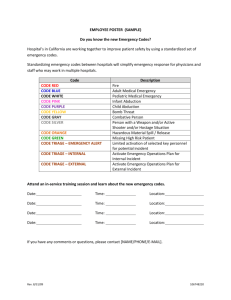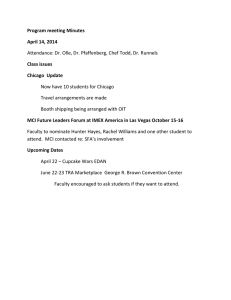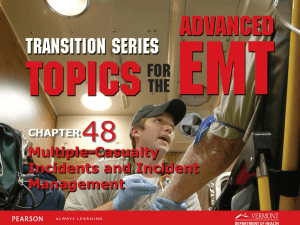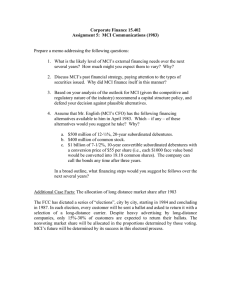Mass Casualty Incidents
advertisement
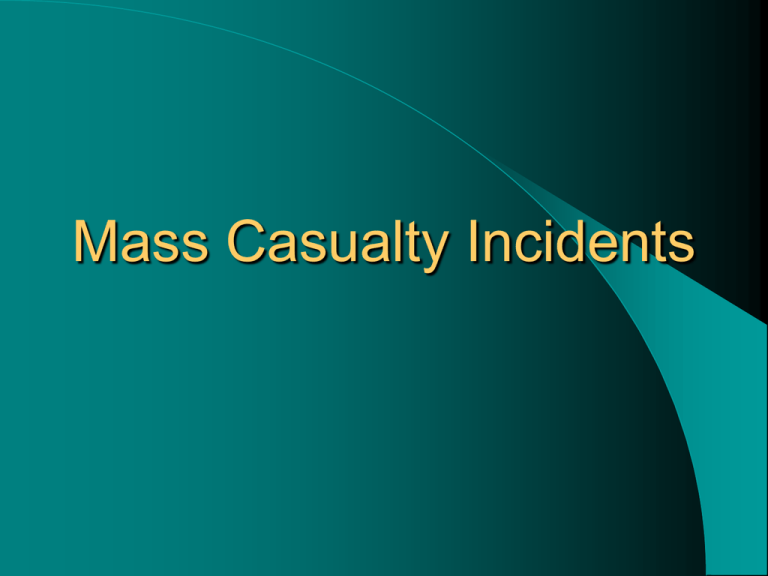
Mass Casualty Incidents What is an MCI ? It is any incident where the number of patients and/or the severity of their injuries prohibits immediate patient care provided to all at that moment. Multiple Casualty Incident It will never happen to me right ? High Risk/Low Frequency events MCI Events in King County: Highland Ice Arena, Shoreline: 76 patients from a CO leak . Chlorine leak at a County Pool, 26 Patients School bus accident in Redmond 60 patients Several MVA’s ranging from 5 to 10 Patients Seattle Aurora Bridge Bus Incident. 33 Patients. Common Problems at an MCI Personnel not fully understanding their roles in an MCI setting. Failure to identify the incident as an MCI Failure to triage properly Improper numbering of treatment tags /Pt’s Inappropriate, time consuming treatment Clogging at the transportation site. Problems… Scene access problems Ineffective response plan for the size of incident. Lack of a large equipment cache on hand Congested treatment areas Transport vehicles left unattended Misconceptions of MCI: Every MCI requires a Medical Group to be set up. I.C. does not need an “Medical Group Supervisor” in a large event. You cannot down grade a patient once they have been triaged. All Immediate or red patients must be transported first. Patients have to go the the closest Hospital. Yellow patients equal BLS patients always. Multiple Casualty Definitions: Ambulance Staging Staging Manager Colored flagging Tape Funnel Point Hospital Control Medical group Supervisor or Branch director Medical Support Unit Morgue area Plan C Triage Tracking Boards Treatment Area Transport Area Treatment Tags Triage Belt Incident Management System MCI plan is based on the same principles of the IMS system. Allows for creation of an organizational structure for the most effectiveness of resources, personnel and equipment. Span of control 3 to 7 with optimal being 5 Is a “Medical Group” or “Medical Branch” needed to effectively manage the incident ? Activation of an MCI Incident Commander’s responsibility to declare an MCI and provide a verbal size up of the incident. Additional resources should be requested early on by the I.C. The I.C. or designee is responsible for initial “Hospital Control” contact and plan activation. Activation of Hospital Control Request “Activation of the MCI Hospital Control Plan” done by the I.C. Transportation Team Leader communicates with Hospital Control PRIMARY: Harborview Medical Center Ask for the “Charge Nurse” This will result in notification of HMC E.R. staff, HMC Physician portable 55, and area Hospitals if necessary. Is a “Lock Down” needed at local Hospitals ? Secondary Hospital Control Overlake Medical Center Request Charge Nurse and provide the same information as you would to HMC. Incident Commander Develop a “Incident action plan” necessary to control the incident. Establish a Medical Group or branch if needed. Ensure that adequate resources are requested for both incident manpower and transport capabilities. Direct incoming resources Establish Command post/location and necessary staging /base areas Incident Management Considerations: Is “Gross Decon” and “Lock Down” notification for hospitals needed ? Buses for shelter and patient transport. Crowd control, separating injured from non. Separate walking wounded from non ambulatory patients. Separate tactical channel for medical Gross Decon Procedure I.C. establishes “gross decon group” Location: prior to funnel point. Once clean, patient is given a Tyvek suit. Disposable blanket if Back Boarded. Attach white flagging tape to wrist. Proceed to funnel point or green holding area. Medical Group/Branch Supervisor Filled by a “Medical Services Officer”or first in Medic Unit officer. Responsible for the over all coordination of the medical group and Hospital control Recommend early activation of Hospital control Ensure proper resources and manpower for the medical group. Responsible for accountability Medical Group Medical Branch vs. Medical Group Medical group supervisor Triage Team Leader Treatment Team Leader Transportation Team Leader / ambulance staging manager Morgue Team Leader Triage Team Leader Filled by a Company Officer Accountable for litter barriers and equipment for back boarding. Responsible for setting up a funnel point Responsible for proper triage including numbering/flagging of patients Responsible for clearing Patients after gross deacon needs are complete prior to treatment area. Funnel Point Procedure V shape set up with saw horses, and a white flag to identify the funnel point. Pre number treatment tags prior to Patients arriving. Use division numbers for multiple funnel points. Re-triage “ Safety Net” Mark the treatment card, and patients forehead, cheek or arm. Attach the tag to the colored tape Treatment Team leader Filled by driver of first in medic Unit Sets up Treatment area using supplies from Medic Units and MSU vehicles. Responsible for the over all treatment in all areas. Appoints treatment area leaders. Ensure adequate resources and proper documentation is complete on each tag. Coordinates Pt. Loading with Transport. Transport Team Leader Filled by experienced EMT, Medic or MSO Responsible for the loading, transporting and accountability of all patients. Coordinates the destination with Hospital Control. Ensures proper transport resources. Documents all information on a tracking form using an aid. Consider using an ambulance supervisor Hospital Control Utilize cell phones or 800 radios Make contact with HMC Charge nurse. Transport Team leader advises them of the condition of the patient. Hospital control advises to which hospital to transport to. Hospital controls calls ahead, not the unit transporting. Communication Problems If no phone access, use the following guidelines. First 10 patients go directly to HMC 1 or 2 red patients may be sent to other regional level 3and 4 trauma centers. Use caution transporting to local hospitals. They may be inundated with self-directed patients. Ambulance staging Separate from manpower staging. Assign a Staging manager. Consider using the Ambulance supervisor for that. All personnel stay with their vehicles Position units in staging to allow easy access to the transport post. Morgue Team Leader Filled by an EMT, P.D. or KC M.E. Responsible for scene security of the deceased. i.e.. personal effects Coordinates duties with Police and the Medical Examiner. Documents Morgue activities If body is moved, mark the spot with a flag. First Arriving Unit Size-up the incident. MCI Yes or No? Announce you have an MCI to incoming resources Call for additional resources. Consider the need for specialty equipment such as an MSU vehicle. Establish command. BE Command Make assignments for incoming companies. Base units. Secure ingress and egress routes. Initiate triage Triage Equipment Triage Belt with triage tape with red, yellow, green, black/white rolls. First Aid Bag attached to belt to provide 5 pressure dressings. Two inch Tape Marker “water resistant” Triage Criteria 30 seconds per patient Using the ABC or RPM approach. Awake / Airway Breathing Circulation, “presence of a radial pulse” Attach the proper triage colored tape to the wrist. Document onto a piece of 2” tape. Harvesting Patients: Recommended four litter barriers per back board for an adult patient. Recommended two litter barriers per back board for a pediatric patient Three straps per board for an MCI Duct Tape may be used in place of cloth straps. Large resources needed for litter barriers. Labor intensive. Remember… The Key to the success of an MCI is early recognition that you have an MCI and to respond the appropriate resources early on. Be Familiar with your own Departments polices/procedures. Know your equipment. Train on MCI. BE PREPARED !!
